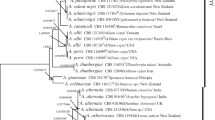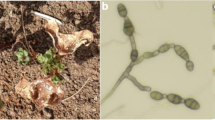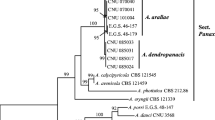Abstract
Perithecia at the base of dead flower stems of pyrethrum (Tanacetum cinerariifolium) plants in yield-decline affected fields of northern Tasmania were identified as Alternaria infectoria and Stemphylium herbarum. Identification was based on morphological description of cultures established from single ascospores; and conidiospores; ascospore shape and septation; and multigene phylogenetic analyses using the internal transcribed spacer (ITS) region, translation elongation factor 1-α (EF1), polymerase II second largest subunit (RPB2) and glyceraldehyde 3-phosphate dehydrogenase (GAPDH) genes. Stemphylium herbarum produced necrotic leaf lesions on both sides of the spray inoculated pyrethrum leaves which coalesced to encompass the entire leaf in in vivo and in vitro experiments. Alternaria infectoria produced small necrotic leaf lesions on both sides of the leaves two weeks after inoculation which did not expand and hence, was considered as a minor pathogen of pyrethrum. This is the first report of A. infectoria and S. herbarum as pathogens of pyrethrum in Australia. The role of A. infectoria and S. herbarum in pyrethrum yield-decline in northern Tasmania needs to be evaluated.






Similar content being viewed by others
References
Ahmed A (2014) Stemphylium grey leaf spot disease of lupins in Western Australia. PhD, The University of Western Australia
Ambrizic DJ, Kovac M, Zel J, Camloh M (2007) Pyrethrum (Tanacetum cinerariifolium) from the northern Adriatic as a potential source of natural insecticides. ANNALES Ser Hist Nat 39–46
Andersen B, Sorensen JL, Nielsen KF, van den Ende BG, de Hoog S (2009) A polyphasic approach to the taxonomy of the Alternaria infectoria species group. Fungal Genet Biol 46:642–656
Barimani M, Pethybridge SJ, Vaghefi N, Hay FS, Taylor PWJ (2013) A new anthracnose disease of pyrethrum caused by Colletotrichum tanaceti sp. nov. Plant Pathol 62:1248–1257
Berbee ML, Pirseyedi M, Hubbard S (1999) Cochliobolus phylogenetics and the origin of known, highly virulent pathogens, inferred from ITS and glyceraldehyde-3-phosphate dehydrogenase gene sequences. Mycologia 91:964–977
Camara MPS, O'Neill NR, van Berkum P (2002) Phylogeny of Stemphylium spp. based on ITS and glyceraldehyde-3-phosphate dehydrogenase gene sequences. Mycologia 94:660–672
Carbone I, Kohn LM (1999) A method for designing primer sets for speciation studies in filamentous ascomycetes. Mycologia 91:553–556
Crous PW, Verkley GJM, Groenewald JZ et al (2009) Fungal biodiversity. CBS Laboratory manual series 1. CBS-KNAW Fungal Biodiversity Centre Utrecht, The Netherlands
de Hoog GS, Gerrits van den Ende GH (1998) Molecular diagnostics of clinical strains of filamentous basidiomycetes. Mycoses 41:183–189
Guindon S, Gascuel O (2003) A simple, fast, and accurate algorithm to estimate large phylogenies by maximum likelihood. Syst Biol 52:696–704
Hay F, Stirling GR, Chung B, Groom T (2002) Investigation into the cause of pyrethrum regrowth decline (RPD) with emphasis on the role of plant-parasitic nematodes. Horticulture Australia, Sydney, NSW
Hay F, Gent DH, Pilkington S, Pearce TL, Scott JB, Pethybridge SJ (2015) Changes in distribution and frequency of fungi associated with foliar diseases complex of pyrethrum in Australia. Plant Dis 9:1227–1235
Inderbitzin P, Mehta YR, Berbee ML (2009) Pleospora species with Stemphylium anamorphs: a four locus phylogeny resolves new lineages yet does not distinguish among species in the Pleospora herbarum clade. Mycologia 101:329–339
Kearse M, Moir R, Wilson A, Stones-Havas S, Cheung M, Sturrock S, Buxton S, Cooper A, Markowitz S, Duran C, Thierer T, Ashton B, Meintjes P, Drummond A (2012) Geneious basic: an integrated and extendable desktop software platform for the organization and analysis of sequence data. Bioinform 28:1647–1649
Kohl J, Groenenboom-de Haas B, Goossen-van de Geijn H, Speksnijder A, Kastelein P, de Hoog S, van den Ende BG (2009) Pathogenicity of Stemphylium vesicarium from different hosts causing brown spot in pear. Eur J Plant Pathol 124:151–162
Lawrence DP, Gannibal PB, Peever TL, Pryor BM (2013) The sections of Alternaria: formalizing species-group concepts. Mycologia 105:530–546
Liu YJ, Whelen S, Hall BD (1999) Phylogenetic relationships among ascomycetes: evidence from an RNA polymerse II subunit. Mol Biol Evol 16:1799–1808
O’Donnell K, Kistler HC, Cigelnik E, Ploetz R (1998) Multiple evolutionary origins of the fungus causing Panama disease of banana: concordant evidence from nuclear and mitochondrial gene genealogies. Natl Acad Sci 97:2044–2049
Pearce TL, Scott JB, Crous PW, Pethybridge SJ, Hay FS (2015) Tan spot of pyrethrum is caused by a Didymella species complex. Plant Pathol 65:1170–1184
Pethybridge SJ, Hay FS, Groom T (2003) Seasonal fluctuations in fungi associated with pyrethrum foliage in Tasmania. Austral Plant Pathol 32:223–230
Pethybridge SJ, Hay FS, Wilson CR (2004) Pathogenicity of fungi commonly isolated from foliar disease in Tasmanian pyrethrum crops. Austral Plant Pathol 33:441–444
Pethybridge SJ, Hay FS, Esker PD, Gent DH, Wilson CR, Groom T, Nutter FW (2008a) Diseases of pyrethrum in Tasmania: challenges and prospects for management. Plant Dis 92:1260–1272
Pethybridge SJ, Jones SJ, Shivas RG, Hay FS, Wilson CR, Groom T (2008b) Tan spot: a new disease of pyrethrum caused by Microsphaeropsis tanaceti sp. nov. Plant Pathol 57:1058–1065
Rayner RW, Commonwealth Mycological Institute (Great Britain), British Mycological Society (1970) A mycological colour chart. Kew, Commonwealth Mycological Institute
Scott JB, Gent DH, Pethybridge SJ, Groom T, Hay FS (2014) Crop damage from sclerotinia crown rot and risk factors in pyrethrum. Plant Dis 98:103–111
Simmons EG (1967) Typification of Alternaria, Stemphylium and Ulocladium. Mycologia 59:67–92
Simmons SG (2001) Perfect states of Stemphylium-VI. Harvard University Herbaria 6(1):199–208
Srinath KV, Sarwar M (1965) Alternaria blight of pyrethrum. Curr Sci 34:295
Sung GH, Sung JM, Hywel-Jones NL, Spatafora JW (2007) A multi-gene phylogeny of Clavicipitaceae (Ascomycota, fungi): identification of localized incongruence using a combinational bootstrap approach. Mol Phylogenet Evol 44:1204–1223
Tamura K, Stecher G, Peterson D, Filipski A, Kumar S (2013) MEGA6: molecular evolutionary genetics analysis version 6.0. Mol Biol Evol 30:2725–2727
Thomma BPHJ (2003) Alternaria spp.: from general saprophyte to specific parasite. Mol Plant Pathol 4:225–236
Vaghefi N, Pethybridge SJ, Ford R, Nicolas ME, Corus PW, Taylor PWJ (2012) Stagonosporopsis spp. associated with ray blight disease of Asteraceae. Austral Plant Pathol 41:675–686
Wang Y, Fu HB, O'Neill NR, Zhang XG (2009) Two new species of Stemphylium from Northwest China. Mycol Prog 8:301–304
White TJ, Bruns T, Lee S, Taylor J (1990) Amplification and direct sequencing of fungal ribosomal RNA genes for phylogenetics. Chapter 38. In: Innis MA, Gelfand DH, Sninsky JJ, White TJ (eds) PCR protocols: a guide to methods and applications. Academic, Orlando, pp 315–322
Woudenberg JH, Groenewald JZ, Binder M, Crous PW (2013) Alternaria redefined. Stud Mycol 75:171–212
Zhang Y, Crous PW, Schoch CL, Hyde KD (2012) Pleosporales. Fungal Divers 53:1–221
Acknowledgements
Thanks to Botanical Resources Australia- Agricultural Services Pty. Ltd. for providing pyrethrum seedlings and supplementary funding for this project; and to Ruvini Lelwala for isolates of Alternaria sp. Azin Moslemi was supported by a University of Melbourne International Research Scholarship (MIRS).
Author information
Authors and Affiliations
Corresponding author
Electronic supplementary material
ESM 1
(DOCX 62 kb)
Rights and permissions
About this article
Cite this article
Moslemi, A., Ades, P.K., Groom, T. et al. Alternaria infectoria and Stemphylium herbarum, two new pathogens of pyrethrum (Tanacetum cinerariifolium) in Australia. Australasian Plant Pathol. 46, 91–101 (2017). https://doi.org/10.1007/s13313-016-0463-y
Received:
Accepted:
Published:
Issue Date:
DOI: https://doi.org/10.1007/s13313-016-0463-y




